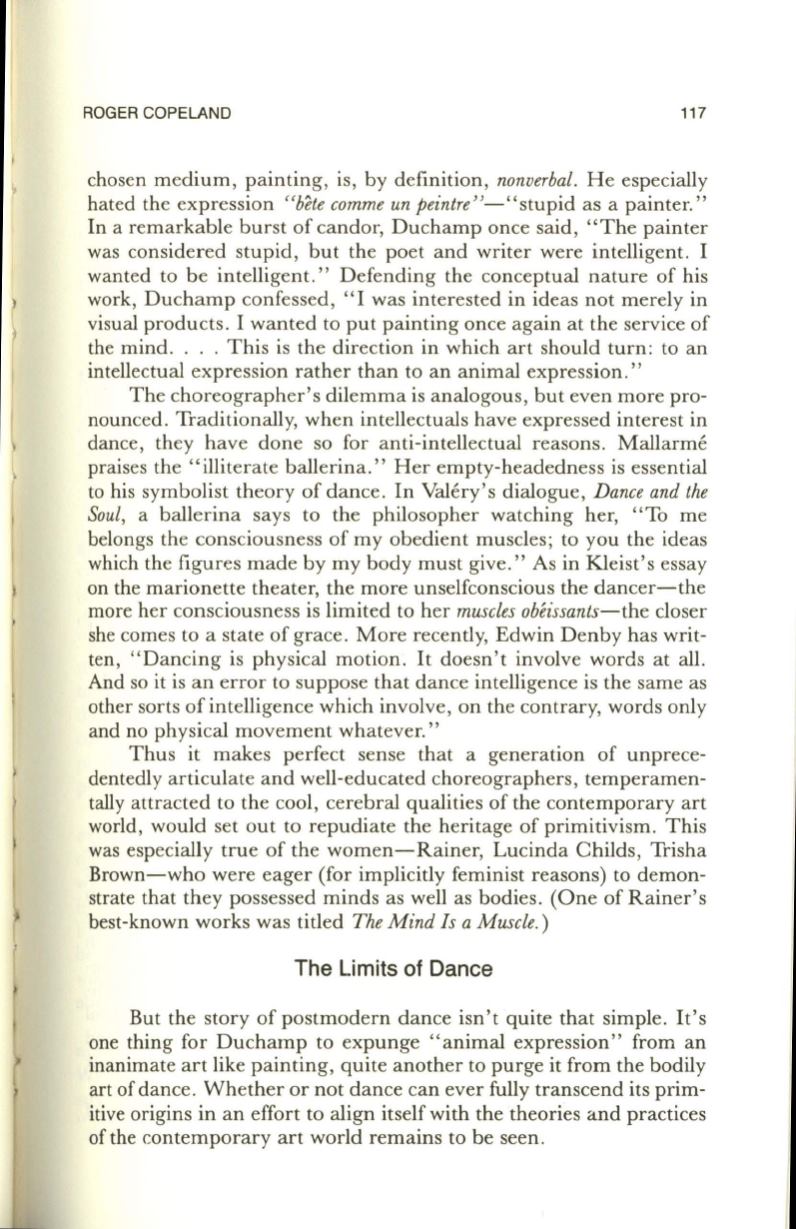
ROGER COPELAND
117
chosen medium, painting, is, by definition,
nonverbal.
He especially
hated the expression
"bete comme un peintre"-"stupid
as a painter."
In a remarkable burst of candor, Duchamp once said, "The painter
was considered stupid, but the poet and writer were intelligent. I
wanted to be intelligent." Defending the conceptual nature of his
work, Duchamp confessed, "I was interested in ideas not merely in
visual products. I wanted to put painting once again at the service of
the mind.... This is the direction in which art should turn: to an
intellectual expression rather than to an animal expression."
The choreographer's dilemma is analogous, but even more pro–
nounced. Traditionally, when intellectuals have expressed interest in
dance, they have done so for anti-intellectual reasons. Mallarme
praises the "illiterate ballerina." Her empty-headedness is essential
to his symbolist theory of dance. In Valery's dialogue,
Dance and the
Soul,
a ballerina says to the philosopher watching her, "To me
belongs the consciousness of my obedient muscles; to you the ideas
which the figures made by my body must give." As in Kleist's essay
on the marionette theater, the more unselfconscious the dancer-the
more her consciousness is limited to her
muscles obeissants-the
closer
she comes to a state of grace. More recently, Edwin Denby has writ–
ten, "Dancing is physical motion. It doesn't involve words at all.
And so it is an error to suppose that dance intelligence is the same as
other sorts of intelligence which involve, on the contrary, words only
and no physical movement whatever."
Thus it makes perfect sense that a generation of unprece–
dentedly articulate and well-educated choreographers, temperamen–
tally attracted to the cool, cerebral qualities of the contemporary art
world, would set out to repudiate the heritage of primitivism. This
was especially true of the women-Rainer, Lucinda Childs, Trisha
Brown-who were eager (for implicitly feminist reasons) to demon–
strate that they possessed minds as well as bodies. (One of Rainer's
best-known works was titled
The Mind Is a Muscle.)
The Limits of Dance
But the story of postmodern dance isn't quite that simple. It's
one thing for Duchamp to expunge "animal expression" from an
inanimate art like painting, quite another to purge it from the bodily
art of dance. Whether or not dance can ever fully transcend its prim–
itive origins in an effort to align itself with the theories and practices
of the contemporary art world remains to be seen.


